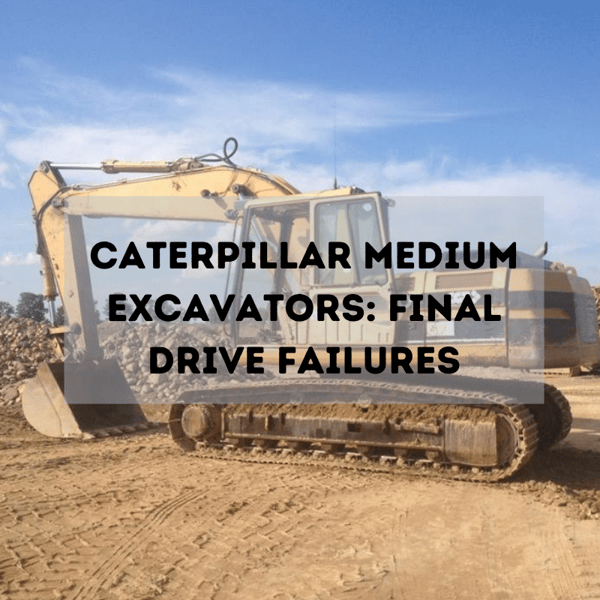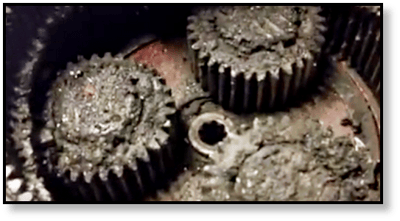Do you own a CAT 320, 325, 330, or 336? Read on to learn about the most common causes of final drive motor failure on these machines.

Here are a few other Shop Talk Blog posts you might find of interest:
- Caterpillar Equipment: High Drives and Final Drives
- 5 Unusual Facts About Caterpillar
- Compact Equipment in the US Military
We commonly discover three issues when opening up a final drive for a CAT medium excavator like the CAT 320, 325, 330, or 336. Two of them are related to gear oil maintenance, and the other involves hydraulic contamination. So let's dive in and talk about them.
Damage to the Planetary Assembly and Coupler
We talk about gear oil often, but with good reason. It's a fact that how often you check and change the gear oil on your final drive (regardless of equipment brand) has a significant impact on MTBF (Mean Time Between Failures) and the useful life of your final drive. If you don't keep an eye on the gear oil, you can be sure that your track motor will fail long before it should.
So there are two common failures associated with the gear oil: damage to the planetary gear set and catastrophic damage to the coupler.
The planetary assembly contains the gear sets responsible for converting speed to the torque needed to move your mid-size excavator. In addition, the planetary assembly, which is physically separate from the hydraulic motor section, contains gear oil to keep everything lubricated and to protect the surfaces of components within.
However, with these particular Caterpillar excavators, there can be an additional problem beyond issues within the planetary assembly itself. The hydraulic motor section and planetary assembly are separate units in these CAT excavators. This creates a unique problem: the coupler is a part of the hydraulic section but is lubricated by the gear oil from the planetary assembly. That means if you don't maintain the gear oil, you can damage the coupler in addition to the planetary gear set.

Now let's talk about what kind of damage can result. First, if the gear oil runs low, the wear on gear teeth, coupler splines, and bearings will happen much faster than usual. This can eventually lead to a drive motor that completely locks up and a CAT excavator that won't move. And if there is a failing seal that allows the gear oil to leak out, that also means that debris like sand, dirt, grit, and water can get inside the planetary assembly and make the damage much worse. And if the gear oil is never changed and just left to age, it takes on a pudding-like consistency and is almost worse than having no gear oil present at all.
Aftermath of Hydraulic Contamination
Another major issue for these mid-size CAT excavators is hydraulic contamination. In these units, contamination often leads to the things:
- Scored swash plates (reduced performance)
- Cracked swash plates (catastrophic failure)
- Lines clogged with debris (reduced performance, failure)
Caterpillar calls hydraulic contamination the "Silent Thief" and considers the topic critical enough that they have a video on it (see below) and an article dedicated to it.
And we've talked a great deal about hydraulic contamination in the context of final drives …
- Hydraulic Drive Motors and Contamination
- 6 Types of Hydraulic Fluid Contamination
- Generated Contamination
- Abrasive Contamination
- Water Contamination
It's vital to keep in mind that hydraulic contamination can shorten the life of your final drive and total it given enough time. And trying to clean up after a final drive contamination failure can be lengthy and costly.
Preventing Common CAT Excavator Track Drive Failures
Our best advice is to start with Caterpillar's guidelines for your machine and perform the recommended maintenance for gear oil and hydraulic fluid at least as often as they advise. If you don't, we can guarantee you're going to have trouble and expensive repairs in your future.
If you don't have access to those maintenance guidelines, we recommend the following:
- At least once a year, you need to be replacing the gear oil in the planetary assembly
- Check the gear oil levels at least every 100 working hours.
As far as hydraulic contamination related to your final drive goes, change the filters at least as often as Caterpillar recommends for your equipment. And don't buy cheap filters -- they're cheap for a reason and will likely not protect your hydraulic system very well. We've got some resources on contamination control, and both Finning CAT and Foley Cat have great resources as well.
Conclusion
You can get the most from your CAT 320, 325, 330, or 336 final drive motors by maintaining the gear oil and protecting your system (including your final drive motor) from contamination. And don't forget to check out Caterpillar's Excavator Maintenance Tips! And if you need a rebuilt final drive for one of these machines, we've got your back!

